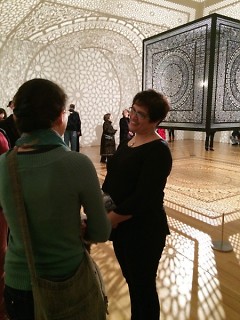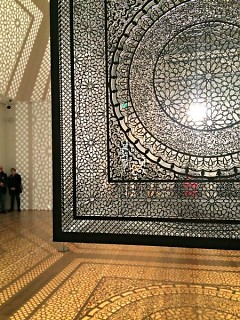"This city has done me the biggest service by embracing the work. It was a controversial work, talking about the divisions between us and what separates us. To be open-minded and to embrace that shows deep compassion and understanding," says Anila Quayyum Agha, winner of the popular and tied winner of the critics' Grand Prize at ArtPrize 2014 with her work at Grand Rapids Art Museum (GRAM). "I am very grateful."
Agha is the Associate Professor of Drawing at the Herron School of Art and Design, Indiana University- Purdue University Indianapolis (IUPUI). Since winning ArtPrize last fall, Agha has seen significant change in her life.
"Right after the Finale, an avalanche of requests for interviews came," she says. "I had a public life previously with my students at the university, but then I came home. Now, my public life followed me home. It was a bit difficult to be consistently 'on' and be ready to respond. I'm not trained like a politician is. Thankfully, it slowed down. I do not mean this in a bad way, I was just not prepared for it."
"I have also started building additional pieces. I built a smaller version of the black piece in stainless steel, only four foot square. It has a different attitude. It's mirrored, and has a lighter feeling than the black piece," Agha adds.
"And, I paid my taxes to the IRS. All of them, which was quite a bit!" she laughs. "But, I can now afford to do my art more easily. I have a part-time assistant now, she's quite wonderful and helps a lot. Steve [Prachyl], my engineer, will also continue to work with me."
Agha says this experience, like much experience, is part of constantly learning about human nature.
"The ability of people to feel joy and hope is the most important thing I've learned this year," she says. "I saw it when people were viewing the work. I personally didn't hear any negative comments when I was there. And then when I won, the applause was sincere. No one felt like I didn't deserve it or that I won on a technicality. It was really joyful."
Agha says her past work differed in technique, material and scale from "Intersections," her ArtPrize piece. She noticed different interactions with the work. Her embroidery on paper works, for example, Agha says women were more responsively them.
"This piece was totally different," she says. "Both [men and women] responded. I didn't receive any type of comments from one group or another that was different. It was all very positive."
With each body of work, she says, she notices the different ways audiences interact with it.
"Each artwork has a different attitude," she says. "Work on the wall will impact less people. It is not as large, it's a more personal experience, solitary. You can control the viewing of the piece by how close or how far you stand to it. Installations and their hugeness have a different impact. It's social and public. And we all see the work through our own experiences. So when art is out there, it is no longer controlled by the artist, the viewer helps make the story complete. Think of it like the difference between how you experience a book and a movie."
Agha would like to continue pushing the boundaries of technique and material with upcoming work.
"[I want] to explore this whole light and dark phenomenon. Also, to work with shadows. I'd also like to build a piece that's different and do some drawings. There are lots of ideas in my head," she says. "The experience of Intersections will be hard to recreate. It feels like the next project needs to be bigger is some way. But, can that synergy be recreated? The amount of viewers, the energy around ArtPrize...I don't know if this is possible."
Agha gave a presentation at the GRAM Saturday afternoon on "The Power of Art to Serve a Lasting and Activist Role," exploring the history of her artmaking that led up to "Intersections" and how all of her pieces explore the ideas of illumination, having an open mind and crossing boundaries. As a female born and raised in Pakistan, she saw the effects of preventing women from getting an education and is quite passionate about literacy.
When she first started making work in graduate school in the early 2000s, there was a lot of conversation about art and craft, what makes something art versus craft and how craft fit into fine art. Inspired by the deep tradition of embroidery of her birthplace, she worked with embroidery on paper, creating holes in prints on purpose to highlight empty spaces and shadows.
She realized that as an artist, she is speaking out and that this was a contradiction to the traditional upbringing of most girls in Pakistan.
"If I want my voice to be heard," she says, "it has to be somewhat as an activist."
Agha's work is full of techniques that let the light in, whether larger embroidered holes, tiny pierced ones, bleach removing color from a textile or now the laser cut wood of Intersections.
"For me, light symbolizes illumination- the opening of the mind- which comes from literacy. The more light you let in, the more people can respect one another. I have a practice that has a social element to it," she says. "Art has the ability to help people be open-minded."
Agha noted that the most beautiful buildings that hold art in historically Muslim are places only the men can go to and enjoy, such as mosques.
In developing her own art practices and languages she was "making that art as placemaking for myself." In doing so, she found a way to invite others in, asking us all to question the boundaries and places we make for each other.
The Rapidian, a program of the 501(c)3 nonprofit Community Media Center, relies on the community’s support to help cover the cost of training reporters and publishing content.
We need your help.
If each of our readers and content creators who values this community platform help support its creation and maintenance, The Rapidian can continue to educate and facilitate a conversation around issues for years to come.
Please support The Rapidian and make a contribution today.


